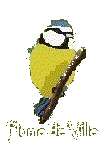Plume de Ville
From day to day.
°°°°°°°°°°°°°°°°°°°°°°° °
July -2- 2008
17 July
The syrphids.
Under
its wasp look this is
a small fly [Diptère]: hoverfly,
flower fly, or Syrphid fly.
This one is feeding on a passion flower. The adult feeds on pollen and
nectar acting
as pollinator. (Fruit of the passionflower at right.)
Probable marmelade fly (Episyrphus balteatus),
[Diptera
Syrphidae].
Its
abdomen
has orange and black stripes and shows two finer bands.
It lays its eggs near aphid colonies; its larvae as the ladybug one are
carnivorous and feed on aphids.
We often see it hovering and the, suddenly it changes direction and
flies away
at great speed.
It is about 1cm long. Protect it, it does not sting, it pollinates and
clears
out aphids. All as a small fly.
Here is a
wasp [Hymenoptera], at right busy recovering the sweet droplets oozing
on the bignonia
flowers.
Common gasp.
(Vespula vulgaris)
-- Social wasp with an underground life --
This is a
syrphid. You can clearly see the head, with its small straight
antennas.
(Maybe a hoverfly (Helophilus) because of the striped chest, wide apart
eyes
and orange legs with black extremities, but I don't have more accurate
photos.
Their larvae develop in water and this one was near a stream.
Another
syrphid.
It is the dead head fly (Myathropa florea) in full toilet, at left the
hind
legs and at right the front legs.
Also a pollinator, but the larvae live in stagnant water, in ponds.
29 July

Colours of heat
and sun in this late July.
The small moth always present (Small Dusty Wave, Idaea seriata) shows us, settled on the glass, its beige abdomen (enlarge).
The
marmalade hoverfly is very interested in inspecting the leaves of a
schefflera that
I just pruned.
I like pears and I end sticky!
Many new
broods of sparrows fledged recently. The edge of the beak of this young
fruit lover
is still yellow.













